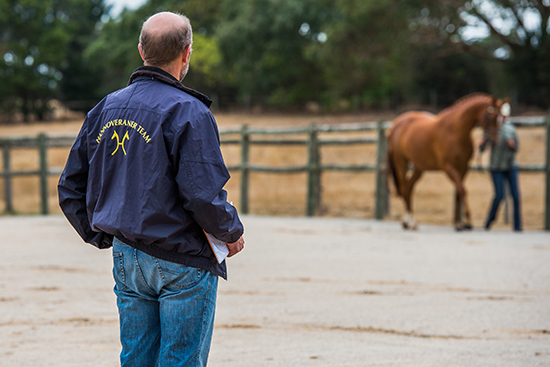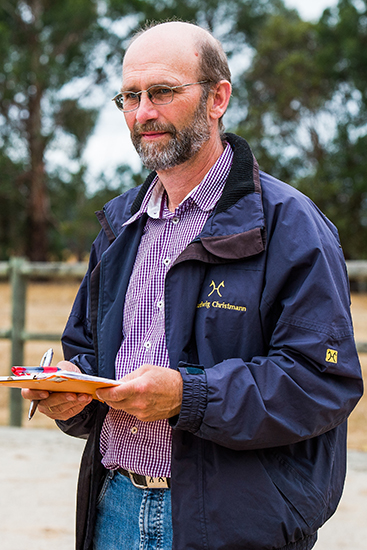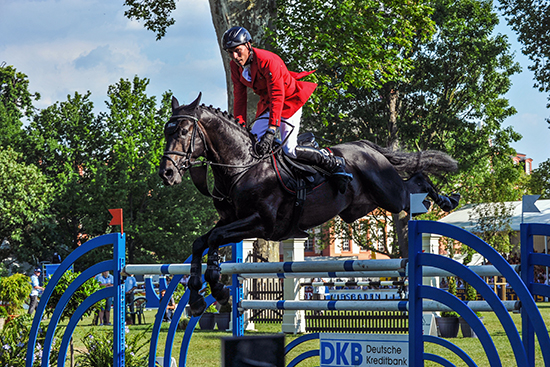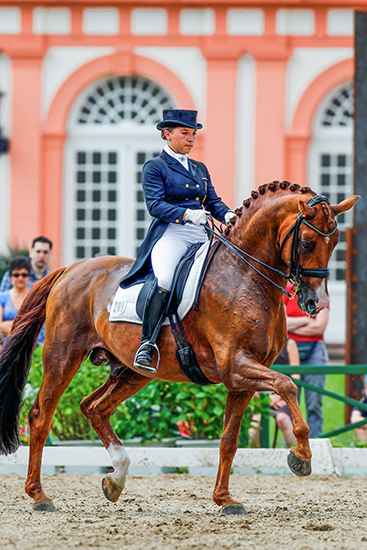 A discussion with Dr Ludwig Christmann, Head of the Department of International Affairs, Development and Education, Hannoveraner Verband
A discussion with Dr Ludwig Christmann, Head of the Department of International Affairs, Development and Education, Hannoveraner Verband
By Christopher Hector
Here’s a little bloodlines test. At the 2011 stallion licensing, colts by the following stallions made premium status: Baloubet du Rouet, Cornet Obolensky, For Pleasure, Hermes d’Authieux aa, Numero Uno. Name the stud book? Give up? I would too – well it’s that old-fashioned, closed and insular group in Germany’s north, the Verband der Züchter des Holsteiner Pferdes.
While the Holstein decision to admit outside jumping blood is surprising in the quantity of outsiders taken into the fold, it is just part of an ongoing pattern that saw first the massive influx of Thoroughbred blood (Ladykiller, Cottage Son) then the crucial influence of the Selle Français (mainly through Cor de la Bryère), what is more shocking for the traditionalist is the willingness to embrace foreign dressage specialists, eight newcomers for the 2012 season – Ampère, Belissimo, Damon Hill, Krack C, Lissaro van de Helle, Quaterback, Totilas and De Niro.
In the latest – 2013 edition – of the Hanoverian Stallion book, there are 69 new licensed stallions admitted into the Hanoverian breeding ranks. Of these, just over half – 35 – are described as ‘Hanoverian’, but when we look a little closer, just over half of these Hanoverians are by non-Hanoverian sires!
The largest group of ‘foreigners’ in the collection of 69 come from neighbouring Oldenburg with six stallions bearing that brand, with five from the KWPN. There are four Westfaliens, three Wüttembürgers, three Holsteiners, two Thoroughbreds, two from the BWP, and one each of the following: Oldenburg Jumping, Arabian, Austrian, Argentinian, Czech, Selle Français, Trakehner and Anglo-Arab.
It really does suggest that the time honoured locally based breeding system, that was the norm for the last couple of hundred years, is perhaps in its death-throes, as the borders come down, and more and more a generic ‘European’ Warmblood emerges, divided now along functional lines: dressage horses, jumping horses and more recently, eventers.
I first met Ludwig Christmann back in 1991 when I participated in the Hanoverian Study Group. It was a great format, we travelled around the breeding area, attending local mare shows, being entertained, wined and dined, in the local stallion station, which in those days was the centre of the social life of the district. Although, it might be pointed out that we were hosted by the men in the area, the women were out in the kitchen, only Elizabeth, wife of the well known breeder and sometime Verband President, Friedrich Jahncke actually sat down and talked to us – how different these days when European breeding associations seem to be dominated by very capable women.
 The Deckstation was where people had parties and celebrations, but first and foremost, it was the place where the local mare owners loyally brought their mares to ‘their’ stallions. Breeding was local local local, and looking at a pedigree, you could not only easily tell which breeding association the horse belonged to, but if you really knew your onions, which district it came from…
The Deckstation was where people had parties and celebrations, but first and foremost, it was the place where the local mare owners loyally brought their mares to ‘their’ stallions. Breeding was local local local, and looking at a pedigree, you could not only easily tell which breeding association the horse belonged to, but if you really knew your onions, which district it came from…
Now of course semen not only travels fast from one end of Germany, or Holland, to another but across the borders just as easily. Recently Ludwig was in Australia, classifying for the Hanoverian Society of Australia, in itself an example of how global horse breeding has become. Ludwig first visited Australia 15 years ago, what was the biggest change he saw in the intervening years – the quality of the mares?
“I think both sides, stallions and mares, have really improved. We also see quality offspring from the mares with a Thoroughbred background. The philosophy to accept good Thoroughbred mares – mares with good legs and movement – has worked, and we see many offspring tracing back to Thoroughbreds, that also have good legs and good movement. That is the key, when you introduce Thoroughbred mares, they need certain qualities.”
“But also many of the breeders have been looking for good mares in Germany. There is a high quality standard of imported mares now in Australia. I have been travelling for only four days, but I am quite impressed with the foals I have seen.”
“Nowadays there is a wider choice of stallions here in Australia, and the breeders also have the possibility to use the frozen semen of the top European stallions, so there is a similar genetic opportunity here.”
“So we see the change on both sides, more quality mares are imported and also on the stallions side with the access to frozen semen and good local stallions.”
Looking at the last couple of licensings of stallions in Germany, including Hanover, more and more blood is coming from outside. The Hannoverian Verband is now taking blood from Holland, from Holstein, Selle Français… are we coming to a stage where there is just a German Riding Horse, which is just the same in Oldenburg, Westfalia and Hanover – the old regional differences are starting to disappear…
“From the outside it may look like that but there are still distinctive differences for example, between the Holsteiner, the Trakehner, and the Hanoverian. These were the foundation breeds – also for other sport horse breeders and in other countries. Hanover was always more open than Holstein and the Trakehner.”
“I still think our horses have their own identity. The aim of all the breed societies is to breed the top sport horses for dressage or showjumping or eventing, but there are different philosophies as to how to reach that aim. At the moment it looks like the traditional ‘big brands’ will stay and there are some tendencies for some stud books, especially in southern Germany, to come together as a joint stud book.”
But if we take out the Trakehners and the Holsteiners who have always had a much more restrictive book, and look at the other big stud books – Westfalia, Oldenburg, Hanover – are there any meaningful differences between those three stud books? They are all using the same bloodlines, and often the same stallions…
“I can only speak for Hanover, and in Hanover we still have higher requirements for non-Hanoverian stallions to be introduced, and also for non-Hanoverian mares coming into our book. Hanover still has an identity of its own, but we are open to use genetics from outside if we have the feeling that these genetics will take us forward.”
Traditionally it was absolutely forbidden to have any Trotter blood in Hanover, but that regulation has been waived to take in the descendants of Galoubet…
“We still don’t want Trotter blood but we see that some lines have produced top jumping horses, but this is not accepted on a wide base.”
There seems to have been a revival of jumping breeding in Hanover, and I think you have had quite a lot to do with that revival, with quite a lot of help from Stakkato…
“There has been a revival. We started with the Jumping Breeding program in the early 90s, and there has been a big motivation for our jumper breeders to participate in this program. With Stakkato we have a top international jumper producer, but there are other bloodlines that are still meaningful, like Grannus and his offspring, Argentinus, For Pleasure, Escudo – his son Embassy II was the most successful German jumping horse in 2012 – and the whole G line. Perigueux is also producing jumpers. I think we are on a very good way.”
 Embassy II, Escudo’s best son, gets the difficult distance at any cost and Hans-Dieter Dreher stays with him!
Embassy II, Escudo’s best son, gets the difficult distance at any cost and Hans-Dieter Dreher stays with him!
Do you see any young jumping stallion in Hanover who can take over from Stakkato?
“To take over from Stakkato is maybe a bit ambitious, but one that is very promising at the moment is Perigueux. He seems to produce very good young horses, and other stallion who we introduced from the Holsteiner side was Contendro, and he has been an excellent producer for us, and there are some promising sons of Contendro. There are some from the ‘G’ line, we will have to see how they develop, like Grey Top, by Graf Top. The Argentinus son, Asti Spumante, has been introduced into the Hanoverian breeding program. We will see…”
With the dressage stallions, it must have been a disappointment that Weltmeyer hasn’t really produced a stallion son, or grand-son, to carry on his line…
“But the genes are still there in the mares. In the end, he was a better brood mare sire than a stallion sire, but the genes are still there, and they helped create the modern dressage horse.”
For a while Donnerhall blood was not used by the State Stud Celle, but eventually he had to be accepted…
“He was introduced into the Hanoverian population quite early. After he won the DLG championship, he was approved by Hanover, and now I think the Donnerhall blood is the leading dressage blood in the world.”
But it was quite a while before the first Donnerhall son was taken into Celle?
“Before the first son went to Celle, Donnerhall was used in the Hanoverian breed, standing on the private Grönwohldhof Stud. Celle has been very important for the Hanoverian breed, but Hannoveraner Verband and state stud Celle are independent organisations, who, of course work very well and very closely together. Private stallion owners, have as well become important in the Hannoveraner breed. “
But less important now, when I first went to Hanover, there were private stallion owners but they were very small compared to the state stud at Celle – but over 30 years, that balance has been turned around…
“There is certainly tougher competition now between the private stallions and the state stallions, and some of the privileges that the State Stud had, could not be continued. It is a more open market, but Celle is in a good way to compete on that market.”
Which stallions would you see as the most important dressage stallions at Celle?
“Don Frederico is the most important, he is really a stallion that produces Grand Prix horses, including Olympic horses. There are other D line stallions like Dancier, that are looking really good.”
Do you see any new young dressage stallions emerging and introducing new lines?
“Introducing new lines is not so easy. There is a big variation of bloodlines, and there are some not so used. The ‘B’ line is a very good line with Benetton Dream, Breitling as a top Grand Prix stallion with Grand Prix offspring, Belissimo and his sons are producing good horses.”
Breitling CAN breed attractive horses, here’s Burlington…
But no one breeds to Breitling, he doesn’t get mares…
“For many years, he was not promoted as a breeding stallion, he was an international Grand Prix competitor until he was 14 or 15. Breeding was not the first motivation of the Wittigs who own him.”
But it is also type isn’t it – they might be great Grand Prix horses but they are not such pretty or modern looking horses…
“Type-wise you are right, he needs mares with a good front end, but sons like Burlington prove that he can produce attractive horses when he is bred to the right mares.”
“I also hope that the Lauries Crusador line will continue to have an influence – his grandson Londontimes looks promising and hopefully he will live up to that promise. A very popular line is the German dressage branch of the Furioso line through Florestan, who was a Rhineland stallion. His sire Fidelio, however, was Hanoverian and his dam descends from the Hanoverian dam line of Erlenklette.”
“A rather new dressage line in Hanover is the line of Quando Quando. Besides his well known grandson Quaterback we licensed a fantastic son last year out of a Donnerhall mare – his name is Quantensprung. We hope he will prove his qualities under saddle. We also see a growing exchange with the leading Dutch bloodlines.”
Do you still have the problem with the breeders wanting to breed to the young stallions all the time, and not use the older stallions?
“I would not say it is a problem. On one side we can be happy that breeders are using young stallions, but some of the young stallions are over-used. There is also a big difference between the dressage breeders and the jumper breeders – the jumper breeders tend to wait and are more hesitant to use the younger stallions. The dressage breeders always want to offer something new for the foal market, but by using the younger stallions, from breeding theory the progress is always in the younger generations. In the long run, I don’t think it hurts our overall population to use the younger stallions.”
The horse business is tough, all through Europe, the auction prices are down, in all the breeding areas less mares are being bred, many of the famous stallion stations and studs have closed down – what next?
“This seems to be a world wide trend, The Netherlands, Denmark, Germany, also here in Australia and New Zealand. But I think when you look at competitions, the number of competitions is still high, look at the sport and you don’t see a downward trend in participation… It is a saturated market in Germany, it’s not growing any more, but it is still a pretty big market. In the USA, you also have many competitions and a big market, and internationally there are new markets emerging – Eastern Europe has come as a market, Asia, some of the emerging countries. I am pretty positive that this is a cycle, and I hope that very soon we have reached the bottom of the cycle, and we will have better sales again in the future.”


